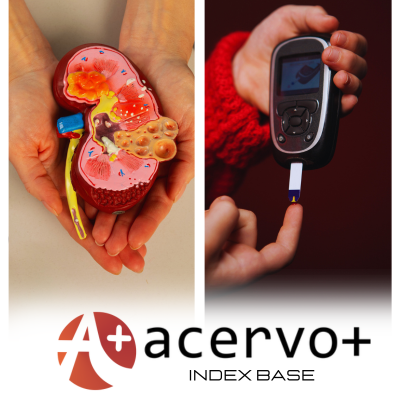Aspectos fisiopatológicos relacionados à doença renal em indivíduos com diabetes mellitus
##plugins.themes.bootstrap3.article.main##
Resumo
Objetivo: Descrever a fisiopatologia da Doença Renal do Diabetes (DRD), bem como definir quais são os aspectos epidemiológicos e o quadro clínico associados a essa enfermidade. Revisão Bibliográfica: A DRD é um acometimento renal que resulta das alterações metabólicas do Diabetes Mellitus (DM), responsável por elevadas taxas de morbidade e mortalidade global. Essa condição pode ser diagnosticada em até 40% dos pacientes diabéticos, sendo mais comum entre aqueles com DM do tipo 2 do que aqueles com DM do tipo 1. Com relação à sua fisiopatologia, sabe-se que a DRD ocorre em resposta às alterações desencadeadas pela hiperglicemia, envolvendo inicialmente hiperfiltração glomerular, seguida por disfunção endotelial e estresse oxidativo. Outrossim, a elevada concentração de açúcares no sangue, a longo prazo, gera produtos danosos a certas células do organismo, em especial aquelas encontradas nos rins. Esses processos, quando combinados, comprometem a função renal, causando o declínio da taxa de filtração glomerular e uma significativa albuminúria. Conclusão: Conclui-se que a doença renal do diabetes é uma complicação microvascular do diabetes mellitus responsável por altos índices de insuficiência renal, cuja fisiopatologia engloba uma série de alterações metabólicas desencadeadas pelo estado hiperglicêmico crônico.
##plugins.themes.bootstrap3.article.details##
Copyright © | Todos os direitos reservados.
A revista detém os direitos autorais exclusivos de publicação deste artigo nos termos da lei 9610/98.
Reprodução parcial
É livre o uso de partes do texto, figuras e questionário do artigo, sendo obrigatória a citação dos autores e revista.
Reprodução total
É expressamente proibida, devendo ser autorizada pela revista.
Referências
2. AMORIM RG, et al. Kidney disease in diabetes mellitus: cross-linking between hyperglycemia, redox imbalance and inflammation. Arquivos Brasileiros de Cardiologia, 2019; 112(5): 577-587.
3. ANDERS HJ, et al. CKD in diabetes: Diabetic kidney disease versus nondiabetic kidney disease. Nature Reviews Nephrology, 2018; 14(6): 361-377.
4. AZEVEDO G, et al. Fisiopatologia e diagnóstico da nefropatia diabética: uma revisão integrativa. Brazilian Journal of Health Review, 2022; 5(1): 3615-3637.
5. BOUÇA B, et al. Nefropatia diabética. Revista Portuguesa de Diabetes, 2021; 16(2): 80-89.
6. CRASTO W, et al. Prevention of microvascular complications of diabetes. Endocrinology and Metabolism Clinics of North America, 2021; 50(3): 431-455.
7. DEFRONZO RA, et al. Pathophysiology of diabetic kidney disease: impact of SGLT2 inhibitors. Nature Reviews Nephrology, 2021; 17(5): 319- 334.
8. FU J, et al. Glomerular endothelial cell injury and cross talk in diabetic kidney disease. American Journal of Physiology – Renal Physiology, 2015; 308(4): 287-297.
9. GEMBILLO G, et al. Kidney disease in diabetic patients: from pathophysiology to pharmacological aspects with a focus on therapeutic inertia. International Journal of Molecular Sciences, 2021; 22(9).
10. GONZALEZ CD, et al. Autophagy dysregulation in diabetic kidney disease: From pathophysiology to pharmacological interventions. Cells, 2021; 10(9).
11. HABIB SL. Kidney atrophy vs hypertrophy in diabetes: which cells are involved? Cell Cycle, 2018; 17(14): 1683-1687.
12. JOHNSON EL, et al. Standards of medical care in diabetes - 2019 abridged for primary care providers. Clinical Diabetes, 2019; 37(1): 11-34.
13. KDIGO. Clinical practice guideline for diabetes management in chronic kidney disease. 2022. Disponível em: https://www.kidney-international.org/article/S0085-2538(22)00507-5/pdf. Acessado em: 22 de junho de 2023.
14. KOYE DN, et al. The global epidemiology of diabetes and kidney disease. Advances in Chronic Kidney Disease, 2018; 25(2): 121-132.
15. LASSÉN E, DAEHN IS. Molecular mechanisms in early diabetic kidney disease: glomerular endothelial cell dysfunction. International Journal of Molecular Sciences, 2020; 21(24).
16. LIN YC, et al. Update of pathophysiology and management of diabetic kidney disease. Journal of the Formosan Medical Association, 2018; 117(8): 662-675.
17. MACIEL RO, et al. Nefropatia diabética – incidência e fatores de risco associados. Brazilian Journal of health Review, 2019; 2(4): 3808-3823.
18. MUSKIET MH, et al. Pleiotropic effects of type 2 diabetes management strategies on renal risk factors. Lancet Diabetes Endocrinology, 2015; 3(5): 367-381.
19. PERKOVIC V, et al. canagliflozin and renal outcomes in type 2 diabetes and nephropathy. New England Journal of Medicine, 2019; 380(24): 2295-2306.
20. REIDY K, et al. Molecular mechanisms of diabetic kidney disease. The Journal of Clinical Investigation, 2014; 124(6): 2333-2340.
21. SPIRES D, et al. Ion Channels and Transporters in Diabetic Kidney Disease. Current Topics in Membranes and Transport, 2019; 83: 353-396.
22. TAKENAKA T, et al. How the kidney hyperfiltrates in diabetes: From molecules to hemodynamics. World Journal of Diabetes, 2015; 6(4): 576-582.
23. TAVARES DM, et al. Diabetes mellitus: fatores de risco, ocorrência e cuidados entre trabalhadores de enfermagem. Acta Paulista de Enfermagem, 2010; 23(5): 671-676.
24. THIPSAWAT S. Early detection of diabetic nephropathy in patient with type 2 diabetes mellitus: A review of the literature. Diabetes and Vascular Disease Research, 2021; 18(6).
25. THOMAS MC, et al. Diabetic kidney disease. Nature Reviews Disease Primers, 2015; 15018: 1-20.
26. UEHARA-WATANABE N, et al. Direct evidence of proximal tubular proliferation in early diabetic nephropathy. Scientific Reports, 2022; 12(778).
27. VALLON V, THOMSON SC. The tubular hypothesis of nephron filtration and diabetic kidney disease. Nature Reviews Nephrology, 2020; 16(6): 317-336.
28. YAMANOUCHI M, et al. Nonproteinuric diabetic kidney disease. Clinical and experimental nephrology, 2020; 24(7): 573-581.
29. YANG Y, XU G. Update on pathogenesis of glomerular hyperfiltration in early diabetic kidney disease. Frontiers in Endocrinology, 2022; 13 (872918): 1-11.
30. YU SM, BONVENTRE JV. Acute kidney injury and progression of diabetic kidney disease. Advances in Chronic Kidney Disease, 2018; 25(2): 166-180.

